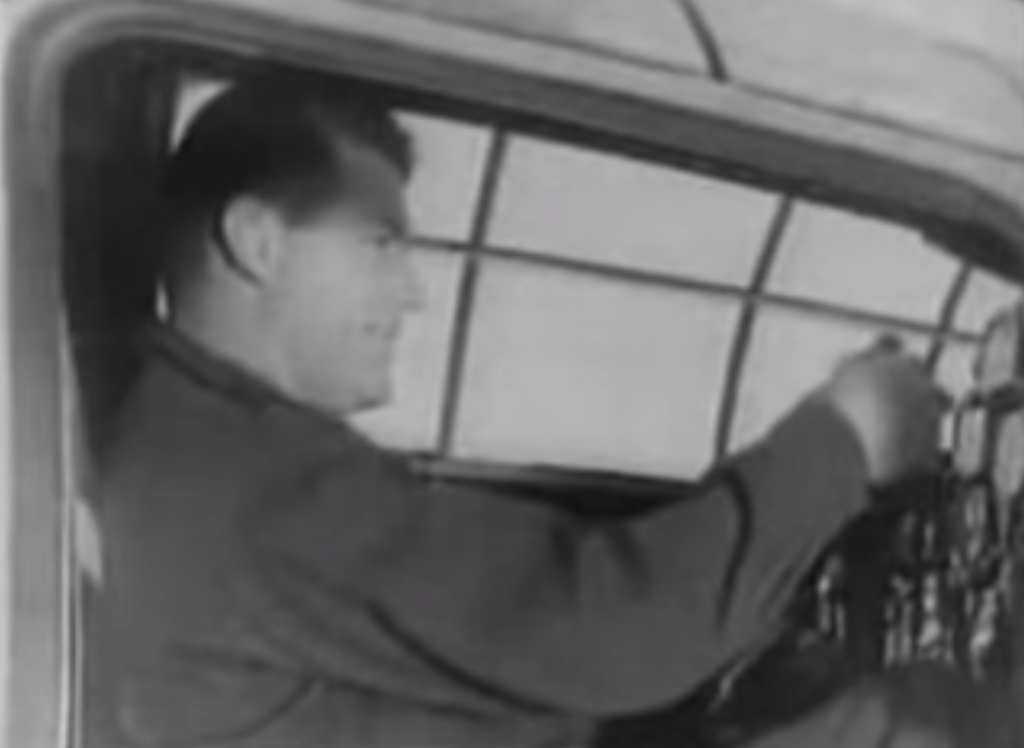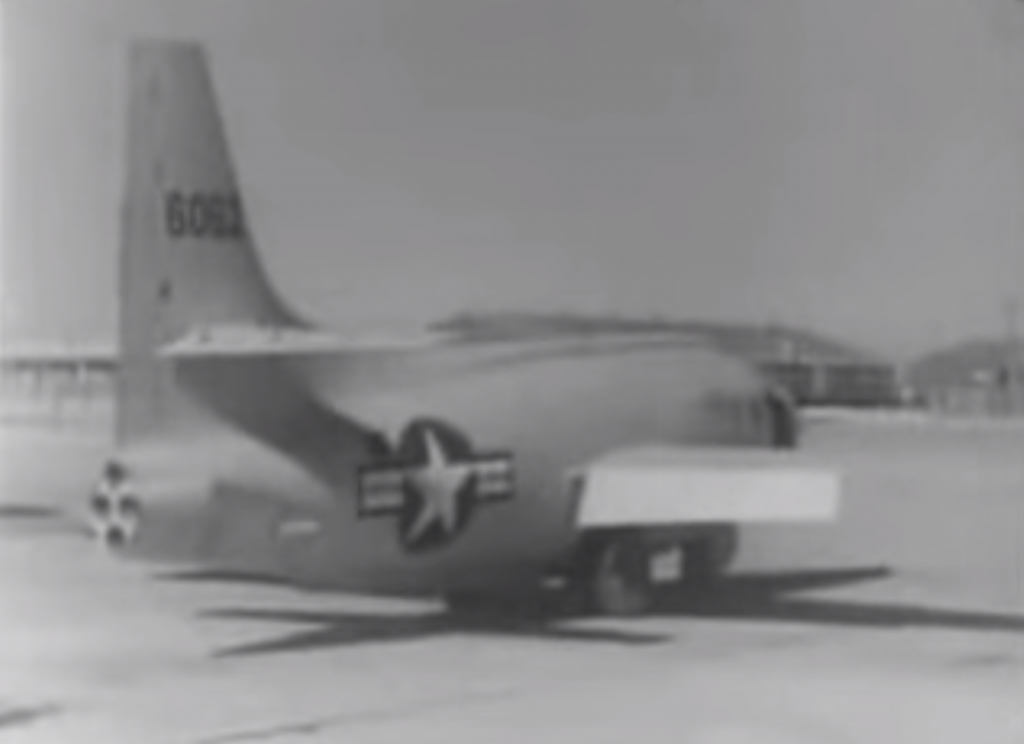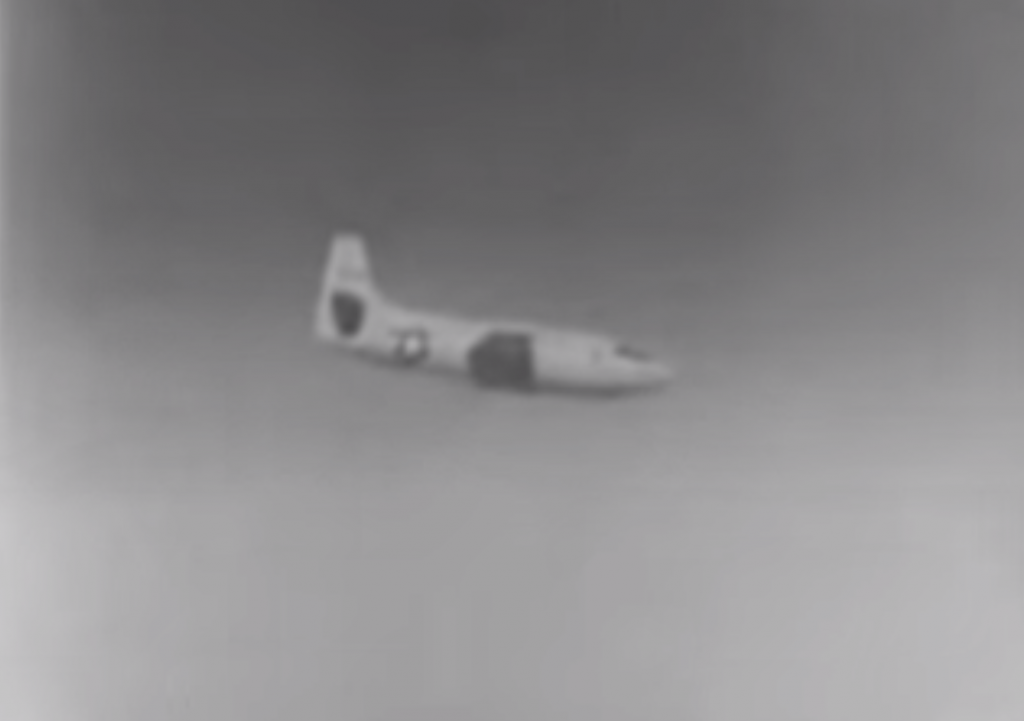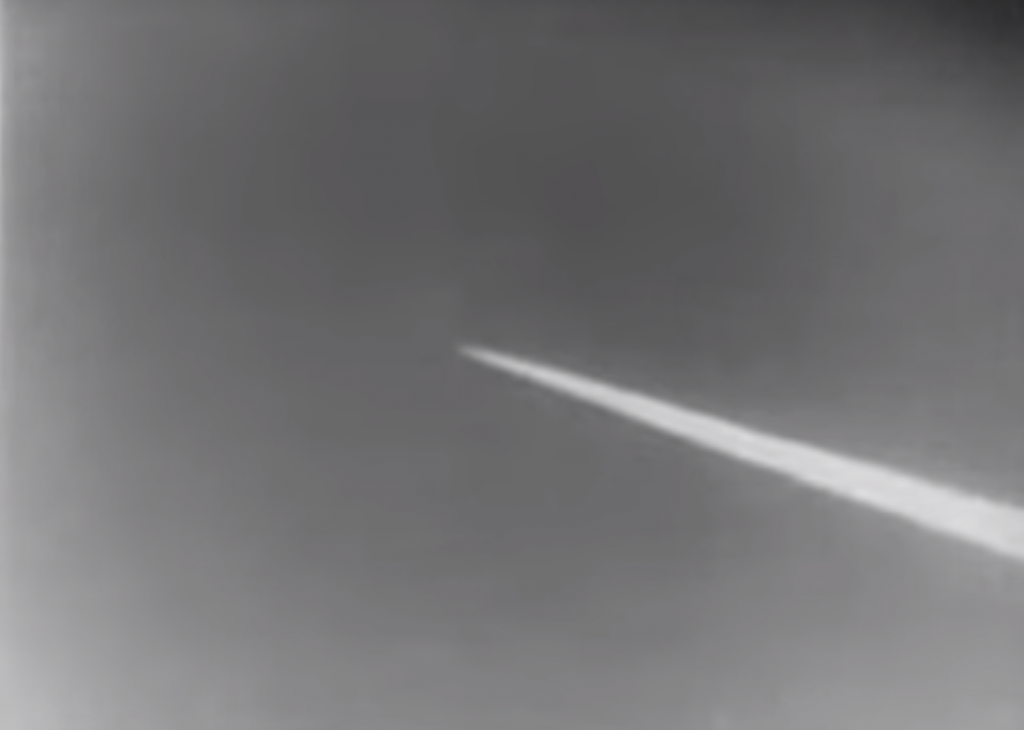TBT: Super Awesome People™ in History.
On October 14, 1947, U.S. Air Force Captain and test pilot Chuck Yeager became the first person to break the sound barrier when he flew the experimental Bell XS-1 rocket plane faster than the speed of sound.
West Virginia-born Charles Elwood Yeager flew for the first time in 1942 at age 19 when he began pilot training in the Army Air Corps. He earned his pilot’s wings in 1943 and joined the 363rd Fighter Squadron and trained in fighter tactics in the states until he shipped out for England in November. Yeager’s first fighter plane was a P-51B which he named Glamourus Glen after his then-fiancee, Glennis Faye Dickhouse. Glennis was Chuck’s “good-luck charm,” and over the years, he named numerous planes after her, including the one that broke the sound barrier. Chuck and Glennis married in 1945 and were together until her death in 1990.

Chuck Yeager (chuckyeager.com) 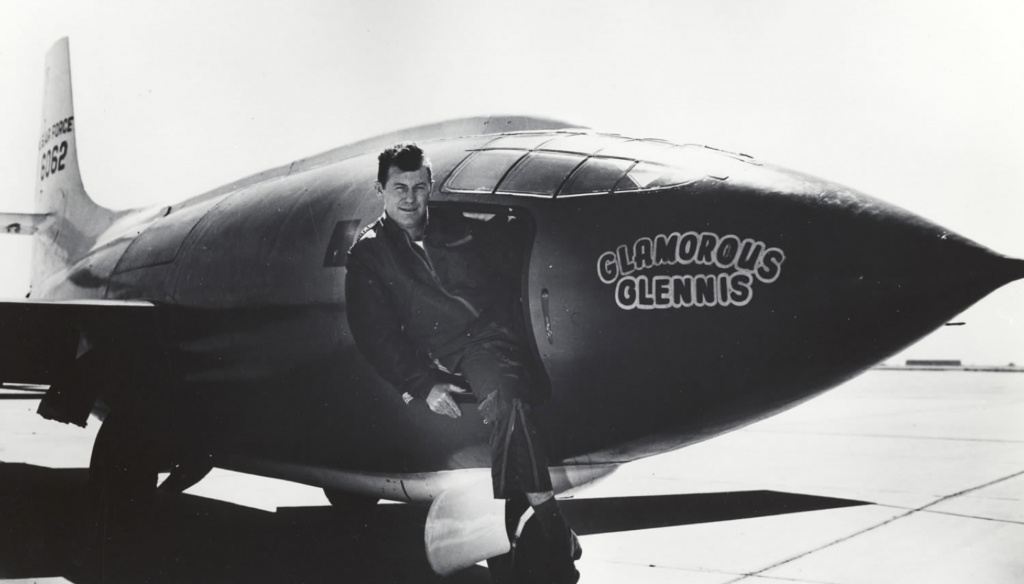
Chuck Yeager on October 14, 1947 (chuckyeager.com)
While serving in World War II, Chuck Yeager flew his first combat mission in February 1944, and by the war’s end, he had flown 64 missions over Europe and shot down 13 German planes (“12.5 victories”). During his eighth combat mission, Yeager was shot down over France, and he was able to escape to Spain and return to his unit in England with the help of French Resistance fighters. Following the war, Yeager worked briefly as a flight instructor in Texas and then joined the Flight Test Division at Wright Field, Ohio, as an assistant maintenance officer.
In January 1946 Yeager was selected as a pilot for the new test pilot school at Wright Field, and in January of the following year, he was chosen as the test pilot of the experimental rocket research plane, the Bell XS-1 (later renamed X-1). Yeager named the plane Glamorous Glennis and flew his first rocket-powered flight on August 29, 1947. Six weeks later, on October 14, the 50th flight of the X-1 (and Yeager’s 9th powered flight), Chuck Yeager became “The Fastest Man Alive” when he broke the sound barrier, attaining a top speed of Mach 1.06, equivalent to 700 mph (1126 km/h). Because of the secrecy of the test flights, Yeager’s feat didn’t become public knowledge until June 1948.
Description of the historic flight from the Smithsonian National Air and Space Museum (where the Glamorous Glennis is on display):
Air-launched at an altitude of 7,000 meters (23,000 feet) from the bomb bay of a Boeing B-29, the X-1 used its rocket engine to climb to its test altitude. It flew a total of 78 times, and on March 26, 1948, with Yeager at the controls, it attained a speed of 1,540 kilometers (957 miles) per hour, Mach 1.45, at an altitude of 21,900 meters (71,900 feet). This was the highest velocity and altitude reached by a manned airplane up to that time.
Newsreel footage from October 14, 1947 documenting Chuck Yeager’s supersonic flight.
For seven years following his X-1 flights, Yeager continued to test-pilot experimental planes at Edwards Air Force Base. In 1954, he took over command of the 417th Fighter Bomber Squadron, and the unit transitioned from air defense to a tactical nuclear mission under his command. In 1962, Yeager (now a colonel) took over as commander of the Air Force’s new Aerospace Research Pilot School, designed to prepare U.S. military test pilots for spaceflight. Yeager returned to combat in 1966 when he took command of the 405th Fighter Wing in the Philippines during the Vietnam War. In 1968, he was promoted to the rank of Brigadier General, and he flew his last active duty flight at age 52 in February 1975.
When he retired on March 1, 1975, Brigadier General Charles Elwood Yeager had accumulated a total of 10,131.6 hours in 361 different types and models of military aircraft. Yeager rocketed to international fame after the publication of Tom Wolfe’s The Right Stuff (1979) and the subsequent film adaptation in 1983, which focused on the aeronautical research at Edwards Air Force Base and the training of the Project Mercury astronauts, with Yeager as a central character in the story.
To commemorate the 50th anniversary of his supersonic flight, Yeager re-enacted the flight with a new Glamorous Glennis III (an F-15D Eagle) on October 14, 1997. He did it again 15 years later (on the 65th anniversary) when he flew faster than Mach 1 at 89-year-old and as co-pilot to Captain David Vincent. Over the decades, the now-97-year-old has received numerous awards and decorations, including the Congressional Silver Medal, the Golden Plate Award of the American Academy of Achievement, the Air Force Distinguished Service Medal, Silver Star, Legion of Merit, Purple Heart, Air Force Commendation Medal, and the Presidential Medal of Freedom. He has been inducted into the International Air & Space Hall of Fame (1966), the National Aviation Hall of Fame (1973), the International Space Hall of Fame (1981), and the California Hall of Fame (2009).
UPDATE: 12/8/2020 On December 7, 2020, Chuck Yeager passed away. He was 97 years old.
Current Vehicle Speed Records: See how Chuck Yeager’s record-breaking flight compares with current record holders for air, rail, land, and water vehicles (as of 10/15/2020).
| Category | Speed (km/h) | Speed (mph) | Vehicle | Operator | Date | Location |
|---|---|---|---|---|---|---|
| Rocket-Powered | 1,126 | 700 | Bell X-1 | Chuck Yeager | 14 Oct 1947 | Air |
| Land Speed Record | 1,227.985 | 763.035 | ThrustSSC | Andy Green | 15 Oct 1997 | Land |
| Wheel-Driven | 745.187 | 463.038 | Vesco Turbinator II | Dave Spangler | 14 Aug 2018 | Land |
| Piston-Driven | 722.204 | 448.757 | Challenger 2 | Danny Thompson | 12 Aug 2018 | Land |
| Motorcycle | 605.698 | 376.363 | Ack Attack | Rocky Robinson | 25 Sep 2010 | Land |
| Diesel-Powered | 563.998 | 350.452 | JCB DieselMax | Andy Green | 23 Aug 2006 | Land |
| Electric-Powered | 550.627 | 342.144 | Venturi VBB‑3 Streamliner | Roger Schroer | 19 Sep 2016 | Land |
| Steam-Powered | 238.679 | 148.308 | Inspiration | Don Wales | 25 Aug 2009 | Land |
| Wind-Powered | 203.09 | 126.19 | Ecotricity Greenbird | Richard Jenkins | 26 Mar 2009 | Land |
| Human-Powered | 144.17 | 89.58 | AeroVelo Eta | Todd Reichert | 17 Sep 2016 | Land |
| Solar-Powered | 91.332 | 56.751 | Sky Ace TIGA | Kenjiro Shinozuka | 20 Aug 2014 | Land |
| Rocket Sled (Manned) | 1,017 | 632 | Sonic Wind No. 1 | John Stapp | 10 Dec 1954 | Rail |
| Maglev Train (Manned) | 603 | 375 | SCMaglev L0 Series Shinkansen | 21 Apr 2015 | Rail | |
| Wheeled Train | 574.8 | 357.2 | TGV POS V150 | Eric Pieczac | 3 Apr 2007 | Rail |
| Propeller-Driven Rail Car | 230 | 140 | Schienenzeppelin | Franz Kruckenberg | 21 Jun 1931 | Rail |
| Steam Train | 202.6 | 125.9 | LNER Class A4 4468 Mallard | Joseph Duddington and Thomas Bray | 3 Jul 1938 | Rail |
| Rocket-Powered (Manned) | 7,270 | 4,520 | North American X‑15A‑2 | William J. Knight | 3 Oct 1967 | Air |
| Air-Breathing (Manned) | 3,529.56 | 2,193.17 | Lockheed SR‑71A Blackbird | Eldon W. Joersz | 28 Jul 1976 | Air |
| Propeller-Driven | 870.38 | 540.83 | Tupolev Tu‑114 | Ivan Soukhomline | 1960 | Air |
| Piston-Engined | 850.24 | 528.31 | Grumman F8F Bearcat | Lyle Shelton | 21 Aug 1989 | Air |
| Helicopter | 400.87 | 249.09 | Westland Lynx 800 G‑LYNX | John Egginton | 11 Aug 1986 | Air |
| Electric Aircraft | 324.02 | 201.34 | Rutan Long‑EZ | William M. Yates | 23 Nov 2013 | Air |
| Glider (Sailplane) | 306.8 | 190.6 | Schempp‑Hirth Nimbus‑4DM | Klaus Ohlmann and Matias Garcia Mazzaro | 22 Dec 2006 | Air |
| Airship | 115.1 | 71.5 | Zeppelin Luftschifftechnik | Steve Fossett and Hans‑Paul Ströhle | 27 Oct 2004 | Air |
| Human-Powered Aircraft | 44.32 | 27.54 | Musculair 2 | Holger Rochelt | 2 Oct 1985 | Air |
| Water Speed Record | 511.11 | 317.59 | Spirit of Australia | Ken Warby | 8 Oct 1978 | Water |
| Propeller-Driven Watercraft | 420.00 | 260.97 | Problem Child | Daryl Ehrlich | 22 Nov 2009 | Water |
| Wind-Powered Watercraft | 121.21 | 75.32 | Vestas Sailrocket 2 | Paul Larsen | 24 Nov 2012 | Water |
| Hovercraft | 137.4 | 85.4 | Universal UH19P Jenny II | Bob Windt | 1 Jan 1995 | Water |
| Human-Powered Watercraft | 34.3 | 21.3 | Decavitator | Mark Drela | 27 Oct 1991 | Water |
| Human-Powered Submarine | 14.881 | 9.247 | Omer 5 | Sebastien Brisebois and Joel Brunet | 28 Jun 2007 | Water |
Read More About Retired U.S. Air Force Brigadier General and His History-Making Flight:
- Chuck Yeager’s Official Website (ChuckYeager.com)
- 14 Reasons Chuck Yeager May Be the Greatest Military Pilot of All Time (Business Insider)
- Chuck Yeager Breaks the Sound Barrier (History.com)
- Pilot Chuck Yeager’s Resolve to Break the Sound Barrier Was Made of the Right Stuff (The Daily Telegraph)
- Punch a Hole in the Sky: An Oral History of The Right Stuff (Wired.com)
- Famous Pilot Yeager Re-Enacting Right Stuff 65 Years Later (Review Journal)
